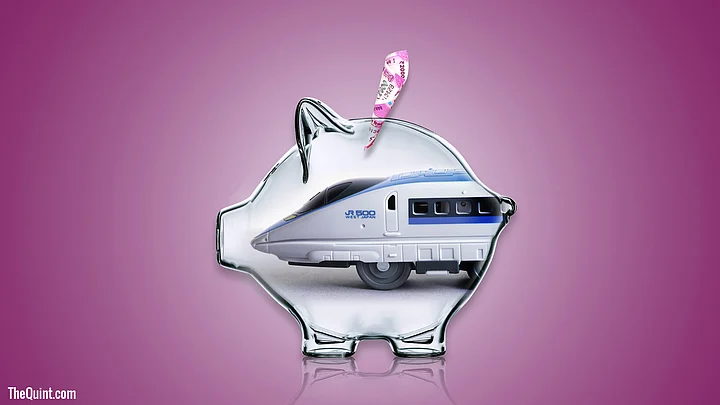(As India and Japan embark on an ambitious bullet train project worth Rs 1 lakh crore, The Quint debates whether the initiative would be economically viable. This is the Counterview. You may like to read the View by Vivian Fernandes here.)
Prime Minister Narendra Modi fancies the bullet train. He could. He has the mandate. But, if it is not co-terminus with logic and national interest, it reflects a misuse of the mandate.
The arguments being advanced by the bullet train-pushers are spurious: “An entire eco-system will come up around manufacturing of locomotives and rolling stock for future bullet trains and component value-chain with thousands of suppliers. ‘Make in India’ would get a fillip. India would export bullet train technology,” wrote Shailesh Pathak in a Times of India blog published on 12 September.
As of now, we are not producing enough coaches and wagons. They need to be manufactured first.
Also Read: 10 Things Modi, Abe Said During Launch of India’s 1st Bullet Train
Does ‘Make in India’ Need a Fillip Through Bullet Trains?
When the total cost is so high, in other words prohibitive (more than Rs 1 lakh crore, seven percent of our budget receipts and more than the 2016-17 Health Mission Budget), its assumed spin-offs are not advantages in real terms.
It is being said that with the high speed rail there would be a reduction in emissions as short-haul flights use imported aviation turbine fuel (ATF) and are large carbon emitters, and that the ATF would be replaced by electricity produced within India.
When did anyone ever measure air pollution caused by short-haul flights? It is said that “Make in India would get a fillip.” What prevents the ‘Make in India’ initiative from getting a fillip now? It is not FDI from Japan. It is only a loan.
The bullet train-pushers say that “this 0.1 percent interest will become a benchmark for future loans (published in Rediff, 14 September 2017)”. No way, as this is a part of the larger deal. Thirty percent of the contracts will go to Japan.
The assertion that “city centre to city centre travel cuts down journey time (published in The Times of India, 12 September 2017)” is also spurious.
If a bullet train takes 140 minutes, without taking into account the usual 30-minute delay, it would take more than half that time to reach Mumbai Central from northern Mumbai by road, if you are lucky to escape a traffic jam (bullet trains will not ply in the suburbs). Even if one includes the one hour needed to reach the airport before the takeoff, air travel won’t take more time than the train journey.
Also Read: Is India “Running” Slow? Bullet Trains in India vs the World
Little Economic Sense in This White Elephant
The absence of “long security drills” (a 10-minute affair), “roaming facility and uninterrupted cell phone connectivity (The Times of India, 12 September 2017)” are being touted as advantages.
It does not make economic sense to create another white elephant. There are at least 10 flights available at below Rs 2,000 (Rs 1,367 to Rs 1,948) for 14 December, from Mumbai to Ahmedabad. Even on 16 September, flights were available for less than Rs 3,000.
Distance between Tokyo and Osaka is 552 km and a bullet train seat costs $126.75, or 14,050 Yen or Rs 8,131.
Apathy of the Railways
The Railways must learn the technology of how not to run two trains on the same track, how to keep the train on its tracks, how to warn vehicles at level crossing, how to stop the rat menace, how to ensure better facilities in sleeper class toilets, how to stop people from travelling on rooftop of trains in UP and Bihar, how to stop suburban trains in Western and other Railways from carrying four times its capacity, and finally how to ensure the safety of all passengers.
Between 19 August and 29 August, there have been seven derailments. The apathy is quite evident. The chairman, who was on extension anyway, hurriedly resigned to escape his responsibility. The GM and a DRM were sent on leave for a while. Ministers may come and go but it’s the bureaucrats with vested interests who are well-entrenched.
That explains why between 2 September and 8 September, there were another eight derailments.
A person who finds it hard to buy petrol for his scooter, should not buy a Benz car –although it is good to have one – just because someone gives a loan at 0.1 percent.
Also Read: Ready for India’s First Bullet Train? Here Are its Top Features
Pending Reforms
There are several projects that were part of railway budgets like anti-collision devices, satellite-based global positioning system, fire-retardant coaches, Vigilance Control Device (if a driver does not perform a certain set of actions, over a period of time, sound alarms, flashing light, and brake systems start operating automatically), and self-propelled ultrasonic rail cars, all of which are yet to see the light of day.
The Railways will still appoint men (possibly a source of ‘income’ through bribes) at unmanned level crossings instead of installing sound and flash device.
Dedicated freight corridors (in 11 years, physical progress is only 37 percent) are pending for over a decade for want of money. Helicopters for accident relief are a dire necessity.
The right thing to do is to hand over the entire job of ensuring safety to the Japanese –the six sigma people – for 10 years at the same cost. That money could be well-spent on tasks pending for years.
(Sources: The Times of India, Rediff)
(The writer is Secretary, Consumer Protection Council, Tamil Nadu. This is an opinion piece and the views expressed above are the author’s own. The Quint neither endorses nor is responsible for the same)
(At The Quint, we question everything. Play an active role in shaping our journalism by becoming a member today.)


